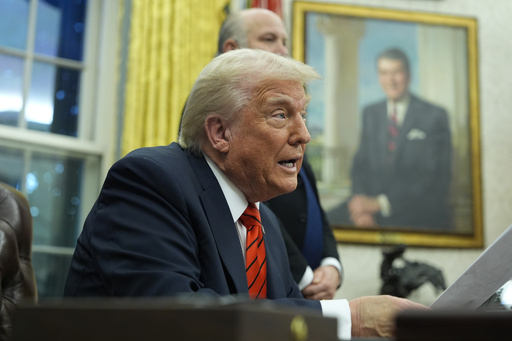
WASHINGTON — On Monday, President Donald Trump announced the removal of existing exceptions and exemptions from the tariffs he initiated in 2018 on steel imports, thereby establishing a blanket tax of at least 25% on all steel coming into the U.S. Furthermore, the tariffs on aluminum imports were raised from 10% to 25%, emphasizing Trump’s commitment to what he believes is necessary for revitalizing American manufacturing.
“These changes reflect a response to the pressures we’ve faced from both allies and adversaries,” Trump declared while signing two proclamations that will take effect on March 4. He argued that increasing taxes on foreign products is vital for the resurgence of U.S. industries to bring manufacturing back home. However, these tariffs will particularly affect close allies, as Canada, Brazil, Mexico, and South Korea rank among the top suppliers of steel to the U.S., according to the American Iron and Steel Institute.
In addition to the tariffs, Trump plans to adjust U.S. taxes on imports to align more closely with those imposed by other nations. This news follows Trump’s previously enacted 10% tariffs on China, as well as retaliatory tariffs from China that began on the same day, and the delayed tariffs planned for Canada and Mexico which are set to kick in by March 1.
Canada’s response was swift, with officials expressing concern. Candace Laing, the president and CEO of the Canadian Chamber of Commerce, depicted Trump’s actions as destabilizing for the global economy and expressed worry over ongoing uncertainty created by the new tariffs.
These tariffs bear a risk of fueling inflation at a time when consumers are already feeling the pinch of rising prices. Voters are increasingly concerned that these tax hikes may outstrip any financial gains they might see. Trump contends that by imposing these tariffs, the international trade landscape will be fairer, enhancing the competitiveness of American factories, despite the potential hardships consumers and businesses may face in the interim.
Benn Steil, an international economics director at a nonpartisan think tank, raised questions about the overall benefits of these tariffs for the U.S. economy. He pointed out that the repercussions of such tariffs may result in increased prices for consumers, retaliatory tariffs from other countries, and reduced competitiveness for U.S. firms that face higher costs for raw materials.
Steil observed that several nations are adopting similar tariff measures under the guise of national security, a stance that is legally protected from challenge at the World Trade Organization. Such tariffs have led various countries to implement new trade barriers on a range of products.
In the previous year, the United States imported nearly 29 million net tons of steel, with only a small fraction coming from China. However, the White House asserts that exemptions granted by the Biden administration allowed steel and aluminum from China and Russia to be routed through third countries.
While steel and aluminum manufacturers may benefit from these tariffs, manufacturers relying on these metals for production—such as those in the auto and appliance sectors—might face increased costs. Glenn Stevens Jr., executive director of MichAuto, indicated that these tariffs would likely force the auto industry to boost prices, potentially decreasing sales and harming profit margins, which could lead to job losses in factories.
“If you look at sudden tariffs in the market, there isn’t typically a favorable outcome,” Stevens noted, criticizing Trump’s assertion that such policies would stimulate job growth in the automotive sector.
The White House has yet to fully address economic analyses predicting that these tariffs could hinder growth and exacerbate inflation, merely stating that this alongside Trump’s suggested tax cuts must be evaluated holistically for a complete view of the economic impact. However, Trump has not yet proposed a comprehensive budget reflecting these policies for economists to assess.
Public sentiment appears worried about inflation increasing further. A recent survey indicated that consumer expectations for inflation over the next year surged from 3.3% to 4.3%. Economists predict that the upcoming government inflation report will show a rise of 2.8% in consumer prices, highlighting concerns that tariffs could be a substantial risk to financial stability.
Following the announcement, shares of steel companies rose significantly, with investors anticipating higher profits due to the tariffs. Cleveland-Cliffs’ shares soared nearly 18%, while other companies such as U.S. Steel and Nucor also saw gains. However, stock prices for firms reliant on steel and aluminum, like General Motors, were negatively affected, signaling potential troubles ahead for the manufacturing sector.
“There are far more businesses using steel and aluminum—like those in construction and automotive markets—than there are producers. The advantage for producers comes with a greater cost to those reliant on these materials,” stated Erica York, vice president of federal tax policy at the Tax Foundation.
As Trump signed the new proclamations, he affirmed that additional tariffs will be imposed on computer chips, automobiles, and pharmaceuticals. Despite the short-term pain anticipated, he argued that these taxes will eventually enable more steel mills and aluminum plants to open domestically.
“You’re going to ultimately see lower prices because more steel is produced in the U.S.,” he claimed, while promising increased job opportunities.
Howard Lutnick, Trump’s nominee for commerce secretary, estimated that the revamped tariffs could create around 120,000 jobs in the U.S., though the origins of that figure remain unclear. After the original implementation of steel and aluminum tariffs, the primary metals industry added about 14,000 jobs, but many of those gains were swiftly negated by the coronavirus pandemic in 2020.
Panos Kouvelis, an expert on supply chains at Washington University, co-authored a study indicating that the 2018 tariffs failed to strengthen the manufacturing sector as promised by Trump. He emphasized that the solution lies in specific incentives targeting advanced technologies rather than broad tariffs on various goods.
“It requires smart, targeted industrial policies,” Kouvelis remarked, highlighting the need for nuanced approaches over blanket tariffs.

